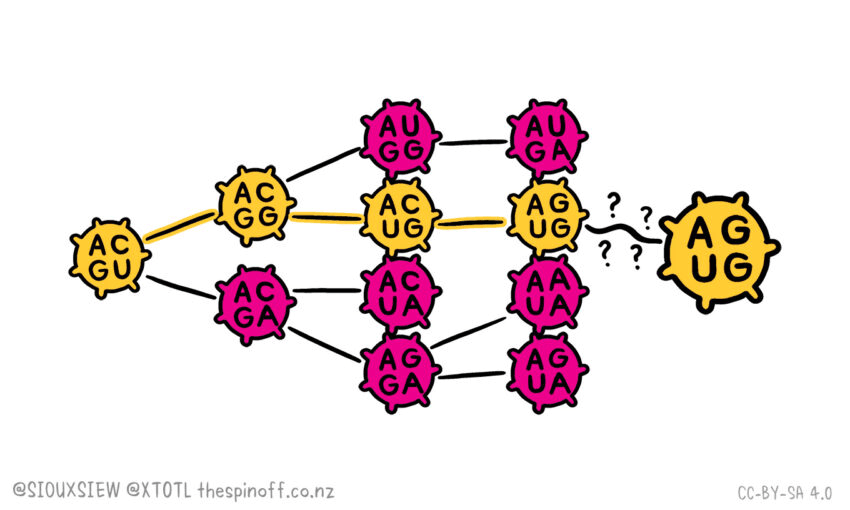The novel coronavirus mutates as it travels between people and around the world. By sequencing the genome, we can try to work out which case is linked with another.
As Aotearoa confronted its first cases of Covid-19 community transmission in more than 100 days, the director general of health, Ashley Bloomfield, raised genome sequencing – something which “may help us track where this virus has arisen from”. Here’s how that works.
The virus responsible for Covid-19 is called SARS-CoV-2. Its genetic material is a strand of RNA made up of almost 30,000 nucleotides. Those nucleotides – adenine, cytosine, guanine, and uracil – are more commonly known by their abbreviations, A, C, G, and U. They code for the amino acids that in turn give us the proteins that make up the virus. Each time the virus enters a new cell and replicates, its genetic material also needs to be copied. It’s here that errors can creep in, replacing the nucleotides that should be at a certain position. These errors are called mutations.
The first SARS-CoV-2 genome was sequenced by researchers at the Chinese Centre for Disease Control and uploaded to the global flu-tracking database GISAID on January 12. That genome came from a swab taken from a man in Wuhan in December and is called the reference genome. Sequencing of more virus samples taken from patients in January showed that some no longer had a G at position 11,083. At some point between December and January, that G had changed to a U.
As time has passed, more nucleotides have changed. It’s happening at a rate of about two a month. As people have transmitted the virus around the world, different changes are starting to accumulate in the virus in different parts of the world. At this stage of the pandemic, if someone picks up the virus in Europe, they are likely to have a slightly different version than if they are infected in the US. If you are interested in seeing how the virus is changing, check out the Nextstrain website.
Sequencing the virus from people who test positive can help to identify whether people are part of the same or separate clusters. Are their viruses identical or near identical or do they have quite different mutations? Back in March, a father and son tested positive after returning to New Zealand from a trip to the US. They got sick within a day of each other. Did they get Covid-19 from the same source? Or was one of them infected first and then passed on the virus to the other? Sequencing of their virus samples showed that the two strains were different. They were infected independently.
Efforts are now under way to sequence the virus from these new community cases of Covid-19 and any others that pop up from the widespread community testing currently happening in Auckland and around the country. If they are all identical or near identical it will point to a single introduction of the virus into New Zealand. Comparing those sequences to the viruses isolated from people recently in managed isolation and quarantine may help to pinpoint the original source. Then it’ll be a case of trying to work out how the chain of transmission happened.
Another possibility raised by Bloomfield yesterday was that the virus may have come into New Zealand through a cold shipment. One of the people who has tested positive works at a cold storage warehouse which handles imports from overseas. That workplace is being swabbed for the virus, which, if found will also be sequenced. Just this week, the South China Morning Post reported that the virus had been detected on packaging of imported frozen seafood in Shandong province. None of the people who had close contact with the seafood batch have tested positive for Covid-19 but they are now in isolation. Interestingly, the Chinese authorities have been routinely testing frozen food and processing workers. This may be another place we need to start monitoring, too, if it turns out this could be a rare but potential route for the virus to enter the country.
If you are interested in learning more about how genome sequencing has been used to understand New Zealand’s Covid-19 cases to date, check out this preprint (it hasn’t been peer-reviewed by a journal yet). A team of researchers from ESR, and the Universities of Otago, Auckland, Victoria, Massey, Sydney, and Melbourne sequenced just over half of the samples collected from patients between 26 February and 22 May. The 649 sequences came from all over the world and helped link cases to clusters. Interestingly, the sequences suggest that only about one in five of the virus introductions resulted in chains of transmission and they were more likely to be caused by viruses originating from North America, rather than from Asia or Australia.


